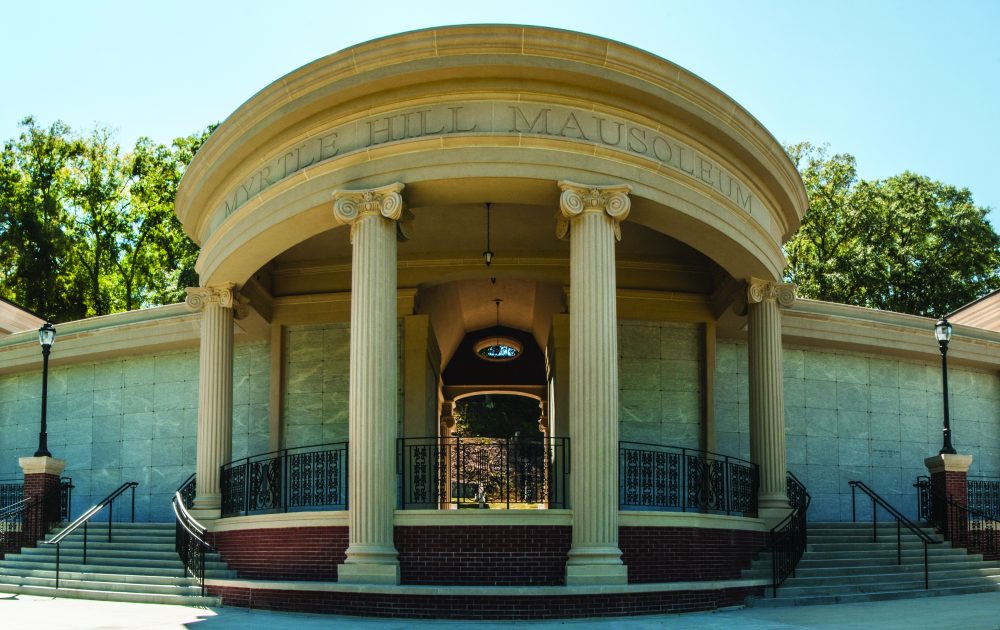
It began with asking the right person the right question. Or perhaps it began with a gift.
It began last fall. Or perhaps it began way back when Homo sapiens first contemplated the connection between being and surroundings.
It will be finished, for now, and dedicated mid-October. But it will mature, endure and flourish after you and I, and generations after us, have shuffled off this mortal coil.
On most days, a breeze will blow, whether it be refreshing or harsh.
It is a spot designed with the purpose of rest for the living in plain view of plentiful eternal resting places, at the foot of Rome’s Myrtle Hill Cemetery. It’s called, for now, simply a meditation garden.
“It’s about being quiet. I just like sitting here,” says John Schulz, who designed the garden.
“In August 2015, Lisa Smith (executive director of the Greater Rome Convention and Visitors’ Bureau) asked me if I would design a garden at Myrtle Hill. She had antique fencing provided by Mike McDougald and a flat piece of land. I told her that I would be delighted and that I would donate my design, consultation, and expertise to assist in its installation.
“I love Rome and, years ago, I decided that one day, before I’m out of here, I would like to build a garden that reflected the seven hills and three rivers.
“Mike McDougald donated the fence and that’s what started it. The fence is very old and well-traveled, and probably has quite a story.” A donated lamp that lit Bourbon Street 200 years ago doubtlessly could tell stories of its own. Add the fact that old Jack Daniels whiskey barrels were used as the forms for the stepping stones, and you’re talking real stories.
“I knew John because I read his books,” Smith said. (Schulz is also the author of two novels and a memoir about his wife’s devotion during his battle against cancer.) “Mike was trying to figure out what to do with the fence. It seemed to fit together.”
“My son liked the idea,” Schulz says. “He told me that he loved walking the road that goes by the garden site.” A few months into the installation, Schultz’s son Paul died, young and unexpectedly. Schultz’s voice trails off whenever the irony arises.
“Forty years ago, my son was bigger than any other kid his age. We taught him the poem about The Little Elf-man,” (by John Kendrick Bangs), Schulz says.
“He and I made Elf-man gardens. Each one had a rock or two for the Elf-man to sit on.
“At one time, I made lots of Elf-man gardens in clay saucers and sold them to florists. Children loved them.
“I began using what I learned about Elf- man gardens in my landscaping endeavors.”
There are four large rocks in the garden that invite you to sit a spell. One rock uncannily resembles an uneven cathedra. Schulz has taken numerous photos of visitors sitting on that particular rock during the installation.
His landscape installations are all over this region, in public spaces and private yards. But this meditation garden may go down as his legacy. “I’ve got one, whether my name’s on it or not,” he says. He likes to quote Harry Truman: “It’s amazing what can be accomplished if no one cares who gets the credit.”
Once Schulz stuck a spade into Myrtle Hill soil, “I got more and more into it. I decided that the plants needed to have some historical and sentimental value. That is a challenge. I have Lenten roses that were given to me by Alberta Hight. I thought those would be nice.
“There has been quite a bit of work by Lisa, Stan Rogers, and others. I think that Stan is particularly proud of the venture, and he has worked diligently on its development. We’ve become good friends.

“My nephew, Daniel de Wit, a SCAD graduate, is very talented and one of his things is concrete art. He is going to perform a custom concrete staining on the two patios, which will have wrought-iron benches. One will be able to sit on the meditation rocks, relax on the benches, or meander on the walkway that represents the rivers.”
Jody Gonzalez will maintain the garden, such as cutting the grass. “Jody does it; whatever it takes, it doesn’t matter,” Schulz says. But he will personally take care of the watering, a task he says invites reflection.
The Thistle Garden Club is sponsoring it.
“I told Lisa that I wanted a 10-year contract on pruning, which I do well,” Schulz says. In 10 years, if tended correctly, today’s plantings will have formed an archway into the garden, one reason Schulz wants rights on the pruning.
“This is a four-dimensional art form of height, depth and width. Then you bring on the fourth dimension, time.
“You can see this garden from the front, the back, or the sides. Or you can see it from the inside. That’s basically a philosophy I use on all my landscape designs.
“This will be my favorite meditation place. For the first time in my life, everybody just turned me loose.”
Sitting in the garden on a sweltering afternoon, watching the installation take place, Felix Mendelssohn’s Octet in E-flat Major, especially live performances I’ve seen, came to mind. Unlike all the quartets and trios and sonatas in the world, the Octet is, by nature of its name, performed by a larger ensemble. The musicians alternate among melody, accompaniment, and rest.
But the eyes of the players keep looking to the principal violinist.




